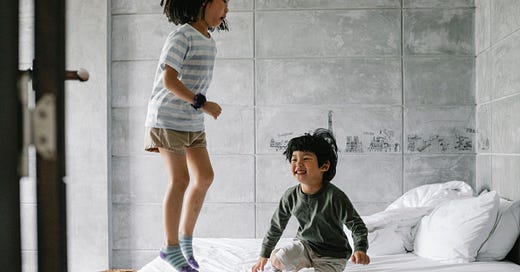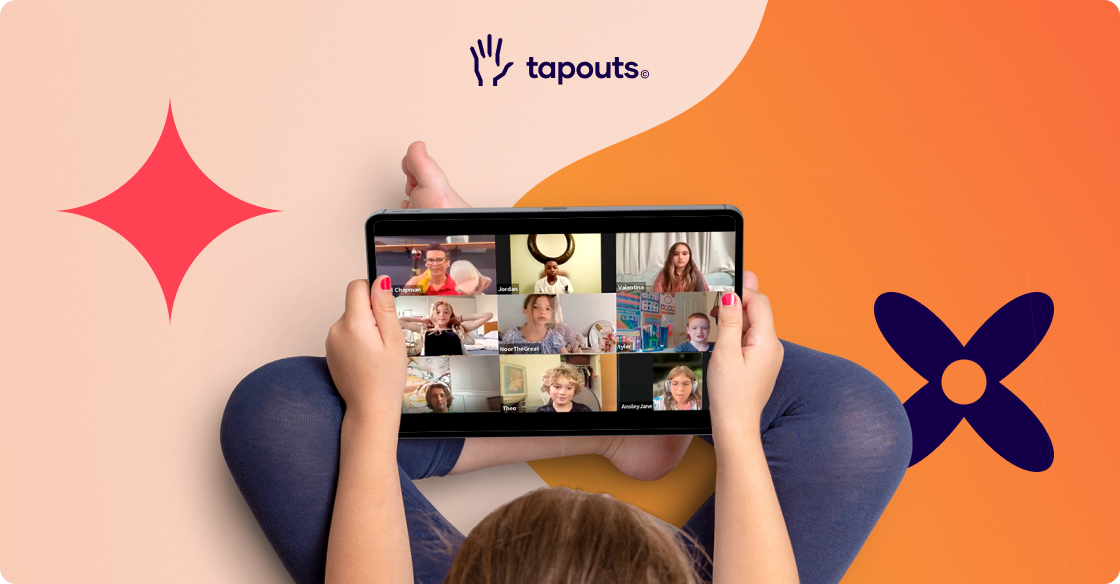Hi! I’m Jacqueline Nesi, a psychologist and professor at Brown University, co-founder of Tech Without Stress, and mom of two young kids. Here at Techno Sapiens, I share the latest research on psychology, technology, and parenting, plus practical tips for living and parenting in the digital age. Subscribe to join 20,000 readers, and if you like it, please share Techno Sapiens with a friend!
6 min read
It’s my son’s bedtime—or, actually, 20 minutes past. The spaghetti bolognese has been wiped from his face; the desired stuffed animals have been gathered;1 the stairs have been climbed. And now we’ve reached the final frontier: the bedtime routine.
Clothes must be removed and replaced with pajamas. Teeth must be brushed. Stories must be chosen and read.2 It seems so simple. And yet.
He wants the pajamas with foxes not spaceships. He wants to take his socks off himself. No, actually, he wants Mom to take his socks off first, but then put them back on, so that he can do it afterward. I’m running away! He shrieks. His to-do list before tooth-brushing is immense. He needs, for example, to unroll all the toilet paper, squeeze a quarter-cup of Aquaphor on the floor, and grab a swim cap out of a drawer and stretch it like a rubber-band.
I turn to squeeze out the toothpaste, and when I look back, he’s managed to get the swim cap partially on.3 WE ARE NOT PUTTING SWIM CAPS ON OUR HEADS RIGHT NOW. WE ARE BRUSHING OUR TEETH. I find myself saying, my voice stern. I have no hair! He giggles.
Didn’t I go to school for this?
When I was in graduate school, I worked as a psychologist-in-training at a clinic specializing in “Behavioral Parent Training” (see this post), i.e., teaching parents research-backed strategies to manage their kids’ behavior. The psychologists who developed this program also have a book called Parenting the Strong-Willed Child (PSWC).4 A few weeks ago, I was reading the latest edition—strictly for professional reasons, of course—and this bedtime scene was running through my head.
And then it happened: I was reminded of a strategy so simple I had almost forgotten about it. Could it make the bedtime routine go a bit more smoothly? Could I finally put this (toddler) to bed?
The easiest strategy of all: attending
This simple strategy is called attending. According to PSWC:
Attending…is an ongoing running commentary of your child’s behavior.
That’s it. You’re describing what your child is doing, with no questions, no teaching, no instructions. Like a sports announcer describing plays on the field—or, more relevant to some of us, describing Taylor Swift’s presence in the stadium.5
Here’s what attending might sound like with the child in your life (all examples hypothetical):
You are putting Slimy Snake inside your garbage truck!
You are holding the baby’s toes very gently!
You are keeping your spaghetti bolognese on your plate!
Why would we want to do this?
It comes down to the basic science of behaviorism, and specifically, operant conditioning: Behaviors that are followed by a positive consequence are more likely to happen in the future. Behaviors that are followed by a negative consequence are less likely to happen in the future. For our children, our attention is the ultimate positive consequence.6 So, whether it’s because we want to show we’re paying attention to them during playtime, or because we want to reinforce a “good” behavior, attending subtly teaches them what we want them to do.
Though attending tends to work best for younger kids (roughly ages 2-6), the basic principle—paying attention to the behaviors you want to see more of—apply at any age. Even for teenagers, paying attention to the good stuff (when they’re working hard at school, when they do something small to help out around the house) can go a long way.
When should we do this?
Here are three situations where attending might be a good idea:
When trying to change a behavior. Are you at your wit’s end trying to change one of your child’s annoying behaviors? Maybe they think it’s hysterical to put their arms in their pant legs every time they get dressed. Maybe they refuse to put down the iPad. Try attending. E.g., You are putting your arms in your sleeves! You put your iPad down the first time I asked!
When playing with your child. It’s very easy to fall into a pattern of asking lots of questions (Are you putting Slimy Snake into your truck?) and teaching (Do you know what sound the letter S makes?) while playing. And these are great things to do! But for some kids, when we do them too much, they can turn playtime into work. Attending is a good alternative. It shows our kids that they have our attention, without asking anything of them except to play.
When trying to increase compliance. If your bedtime scene is anything like mine, you spend a lot of time issuing instructions (It’s time to brush your teeth. Please take that swim cap off your head.) Then, once your child follows the instruction, you go silent, lest you disrupt this fragile success. But remember: water what you want to grow. Give attention to the things you want your child to do more often. As soon as your child takes their first step toward following the instruction, try attending. You’re walking toward the sink! You’re opening your mouth! You’re grabbing your toothbrush! Yes, you’ll feel ridiculous. But you also might feel less frustrated and sweaty by the time you tuck their tiny (shockingly energetic) body into bed.
Note: you should not attend to unwanted behaviors. If attending increases the likelihood a behavior will occur in the future, you don’t want to say things like You’re screaming! Or You’re running naked through the house while I chase after you with pajamas!
Remember, too, that attending is just one strategy in your toolbox. You will need to use other strategies, too, like rewarding good behavior and setting rules and consequences for unwanted behavior. This is especially true if your child is doing something dangerous to themselves or others (hitting, biting, refusing to hold your hand when crossing the road).
It’s bedtime again
Over the past few weeks, I’ve been trying to practice attending more often with my toddler. I’ve been describing a lot of Magna-Tiles castles and toy garbage trucks,7 a lot of different foods that have stayed on plates, and, of course, a lot of toothbrushing and pajama-wearing. Has it been a silver bullet for the bedtime routine? Of course not. Nothing in parenting is ever so simple.
But I have noticed a difference. I’m issuing fewer instructions. He’s (sometimes) following them. And maybe most importantly, I’m noticing the tiny victories (you took your socks off! You grabbed the toothbrush yourself!).
Oh, and I hid that swim cap in a closet somewhere. That helped, too.
A quick programming note. Hi again, sapiens! We’re trying something new here at Techno Sapiens HQ (i.e., my couch). In the coming weeks, I’ll be experimenting with sponsorships. My goal is to partner with mission-aligned brands I’m excited about, to introduce you to products you might be interested in, too. I’m hoping this will be a win-win: a fun way for you to discover stuff you might like, and, also, a way to keep Techno Sapiens up and running, outside of paid subscriptions (since I know those aren’t for everyone). Importantly, sponsors have no say whatsoever in the content of the newsletter—that’s still all me (and, sometimes, my bolognese-covered children). If you have ideas, feedback, or interest in partnering with Techno Sapiens, please reach out anytime (technosapiens.substack@gmail.com). As always, thanks for your support!
Sponsored by: tapouts
Growing up, I played lacrosse. I spent hours–and I mean hours–with my coaches and teammates, learning skills like: how to scoop up a ball with a stick, and how to shoot a ball at the middle-left side of a right-handed goalie.
Oddly, in my adult life, these skills haven’t come up much.
You know what skills have come up? Emotional ones. Like how to express feelings, how to make friends, and how to be resilient. I’ve often thought it would be great if kids had coaches, and teammates, to teach those things, too.
tapouts is an interactive program that does just that. Kids join a group of similar-aged peers for expert-led virtual coaching sessions, once a week for 30 minutes. Through games and activities, kids progressively learn skills for resilience, drawing on best practices in psychology and education. My kids are too young to participate right now (it’s for ages 4-16), but more than 25,000 families have tested it out, and 77% of parents said their child was less stressed after 16 weeks. Plus, 93% of kids said the sessions were fun!
To try it out - take the assessment on tapouts.com and schedule a free discovery session and 50% off your first month using code TECHNO50.
A quick survey
What did you think of this week’s Techno Sapiens? Your feedback helps me make this better. Thanks!
The Best | Great | Good | Meh | The Worst
The number of stuffed animals in our house now outweigh the number of people by about 30:1. Many of these stuffed animals are beautiful—high quality, some even handmade. My toddler’s favorite? “Puppy,” a small black lab whose plastic eyes have been scratched beyond repair and who wears a Christmas-themed shirt at all times of year. ‘Tis (always) the season for Puppy.
You’ll notice here that bath time is not part of the bedtime routine. In this case, it happened before dinner, but skipping it would have been okay, too! No judgement here. Also, its effects were about 40% reversed due to said spaghetti bolognese, so that was a miss.
I don’t know where the swim cap came from. It’s possible my husband ordered it in a temporary fit of madness (or, as he called it, “triathlon training”). Also possible that I ordered it for myself during pregnancy, when pelvic pain rendered swimming my only feasible form of exercise. I got very well-acquainted with our local YMCA pool, where I was the youngest swimmer by about 40 years.
I wouldn’t classify my child as particularly “strong-willed.” Except when there are Annie’s Cheddar Bunnies involved. Either way, highly recommend Parenting the Strong-Willed Child for a step-by-step program for managing tough behavior, based on research.
Oh, what’s that? You’re getting sick of Taylor Swift/NFL references? Not me!!!
A gentle reminder that our attention is often a “positive consequence” for kids even when it’s negative attention. Yelling, lecturing, nagging—these are all things we would think are good deterrents, but it often does not work this way. Instead, what can happen is this: our child does a behavior we like, and we just kind of ignore it (because it’s what they’re supposed to do). Then, every time our child does a behavior we don’t like, we get to work yelling and lecturing. Paradoxically, they learn that if they do the unwanted behaviors, they get our attention. A good first step toward breaking this cycle? Pay attention to the good stuff.
My toddler’s toy garbage truck was a “gift” from the baby when he was born. You may remember from this post that there is absolutely no evidence behind the practice of getting your older child a gift from the new baby, despite the Internet’s repeated assertions that this improves the sibling relationship. I did it anyway. It was adorable.





Oh the feeling of fragile success. I’m laughing. Great article
I appreciate your idea about attending. As I read your post, I considered that I probably asked too many questions. Am I turning their play into work? Now, thanks to you, I plan to try attending. You provided a good explanation and several examples. Thanks.